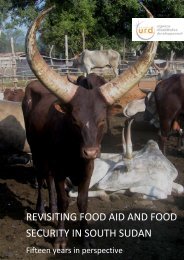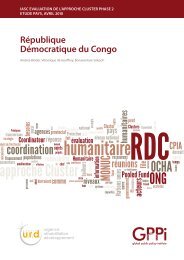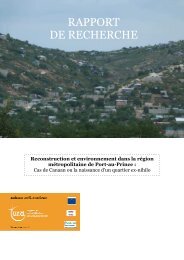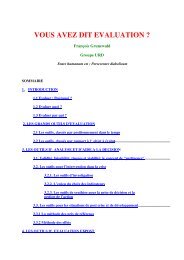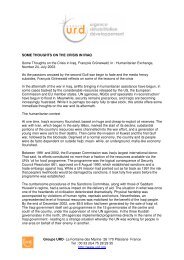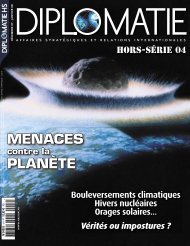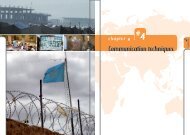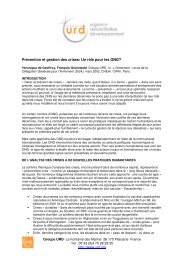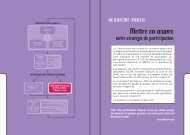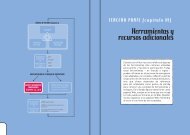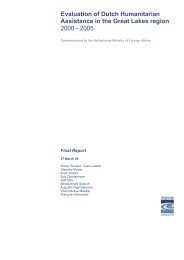Kabul Urban Survey - Groupe URD
Kabul Urban Survey - Groupe URD
Kabul Urban Survey - Groupe URD
Create successful ePaper yourself
Turn your PDF publications into a flip-book with our unique Google optimized e-Paper software.
programmes with communities for upgrading areas and on the other, it is analysing urban<br />
management and planning capacities at the municipal level with “City Profile Programmes”<br />
which have been tested in Kandahar and Herat. <strong>Kabul</strong> Municipality has not yet benefited<br />
from this programme, but UN-HABITAT is present and active both in <strong>Kabul</strong> Municipality and<br />
in the Ministry of <strong>Urban</strong> Development. UNDP will be participating in the coordination process.<br />
Lack of spatial data on <strong>Kabul</strong> city and spatial vision in existing urban analysis<br />
One way of understanding an urban situation is to obtain a spatial overview of the city and<br />
suburbs. The analysis of reconstruction efforts and needs in this transitional period between<br />
rehabilitation and development has constantly been confronted with a critical lack of urban<br />
reference maps.<br />
Reticence for producing urban maps<br />
The fact is that Afghanistan is not accustomed to allowing the general public to access maps<br />
of its territory. Traditionally, cartography and geodesy data were a military concern. A<br />
national administration, the Afghan Geodesy and Cartography Head Office (AGCHO), which<br />
works as a Ministry directly under the control of the Islamic Republic of Afghanistan’s<br />
President, is in charge of topographical and cartography surveys throughout the country. The<br />
maps produced by AGCHO are reserved for strategic matters and gaining access to these<br />
maps for civil issues, such as urban development, is difficult. Furthermore, in the past, very<br />
few urban maps were made, because urban areas were not so important and strategic in<br />
comparison with agricultural areas. Moreover, the different conflicts and resulting population<br />
movement over the past few decades have considerably altered urban expansion patterns,<br />
urban landscapes and de facto the urban knowledge of the real situation. Finally, for several<br />
reasons, such as the top-secret use of topographical data, the succession of wars and<br />
subsequent destruction, outdated urban planning skills and the risk of land property disputes,<br />
few urban maps have been updated and the old ones that exist are completely disconnected<br />
from current geographical data. We have observed lots of different background for spatial<br />
representation of <strong>Kabul</strong> city and in consequences lots of different spatial vision of the city.<br />
Lack of spatial references<br />
In this report, we have written at length about the lack of spatial representation, the<br />
difficulties encountered in obtaining relevant maps, the inexistence of urban plans, the<br />
obsolete administrative spatial references, the absence of cadastral maps, incorrect data on<br />
existing plans, lack of scales and the absence of a detailed urban map. The problem is not<br />
so much having to cope without the necessary maps of the real urban situation, because<br />
satellite images are always available by default. The real problem is what this implies,<br />
i.e. urban authorities do not have a coherent spatial vision for urban issues, nor do they have<br />
an inventory of projects to implement. A considerable amount of work needs to be done on<br />
updating spatial data and establishing an urban planning map.<br />
Lack of coordination and information<br />
There appears to be plans for a coordination mechanism within the MoUD, but in 2006 it is<br />
not yet in operation. There is a lack of coordination at all the levels of decision making,<br />
planning, assessments, surveys, implementation and works. There is no communication<br />
between the institutional actors themselves, but also with civil urban actors and especially<br />
urban citizens. The urban population does not understand why the situation has not<br />
improved. There is the risk that instead of being urban partners, they might become<br />
disruptive components of the urban improvement process.<br />
<strong>Urban</strong> reconstruction mechanisms<br />
Various urban development mechanisms focusing on different development strategies are<br />
currently being put into operation at different levels. The urban sector is so severely affected<br />
that the challenges are multiple. For example, at the national level, the priority is to define<br />
Page 7



